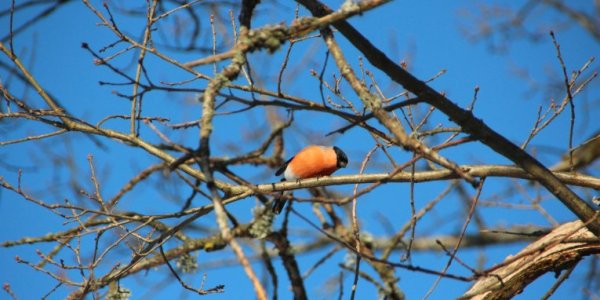Surviving the winter – the primary concern of birds
Despite the fact that the end of the last year was unusually warm, the new year has started with a severe frost and white snowdrifts over the tree tops. For forest animals and birds it is a period of great challenge, it is a hard task looking for food, escaping aggressors and trying to endure until spring.
Last autumn did not want to give up its positions to winter. This was also evidenced by the small animals, which usually at this time of the year already are hibernated in their winter sleep or dead. Some species of flies, mosquitoes, moths, chrysopidae, spiders, opiliones, as well as common frogs showed uncommon activity.
One could easily find blooming flowers, blossoming pussy-willows. Mushrooms were growing in the forest, including edible mushrooms such as chanterelles. Also in December 2001 mushrooms could be found in many place in Latvia, but in 2007 one could go mushrooming in Kurzeme forests even in January.
Competition and safety
Winter solstice shows that astronomical winter has started. Although last year's longest night has ended, the days are still relatively short. For this reason, for animals that are active in daylight, and first of all, for the majority of birds, the beginning of astronomical winter is a stressful period, and days must be used to its fullest. Throughout the unusually long autumn, weather conditions were favourable for birds. And now they need to pick up the required amount of feed in less generous conditions. They must also fight with their competitors for the best places to feed. And of course, watch out for those who would like to eat them.
Small birds are wandering around looking for seeds and insects; due to safety reasons in the winter season when there are more eyes and ears around, they live in small flights. Robins or red-breasts that in winter feed on different seeds and buds, stick together in small separate groups. Also long-tailed tits and titmice of different species hang around in small flights. Usually in these flights there are also a couple of nuthatches and some Eurasian Treecreepers. Right next to the small birds, quite often one can come across the lesser spotted woodpecker, "processing" withered trees. When living in groups the competition is greater, but it is safer.
In contrast, greater piciformes, the black woodpecker and the grey woodpecker, who are looking for insect larvae, live in forests on their own. But great spotted woodpeckers have created their own personal forges. If the meteorological conditions are favourable, they can be heard from sunrise until dusk, peeling seeds and minting cones.
The sea eagle, the largest birds of prey in Latvia, in winter mainly feeds on carcasses of larger animals. Ravens also gather around these places, and from time to time the most common birds of prey in Latvia - buzzards - join them as well. In contrast to the warm season, one can now conspicuously often see jays, corvidae winter vagrants, which looking after one another are raiding around in cawing companies. Magpies though not so friendly with each other, often, however, appear in small groups.
During the entire daylight period, forest spruce-groves are chanted by goldcrests, the smallest haired fliers in Latvia. During this time of the year, goldcrests just like capercaillies, black grouses, hazel grouses, crested tits, and crossbills live only in forests.
Surviving the winter
In winter, we can mainly see resident birds and nomadic birds. The majority of migratory birds are gone, except for some swans, ducks, or maybe a couple of fieldfare or black fieldfare adult males (all females and juveniles have departed). In the concentration areas of other birds, northern goshawks are trying to hunt them some food. They all share their main concern - to survive until spring: to survive the winter, whatever it may be like.












